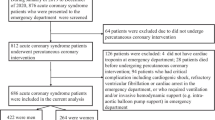Abstract
Background
Invasive risk stratification in patients with acute coronary syndromes (ACS) has been shown to improve outcomes. There is paucity of data on women undergoing invasive risk stratification. We investigated whether the time to coronary angiography affects survival of female patients admitted with ACS.
Method
Female patients admitted to the coronary intensive care unit with ACS between 1/1/97 and 12/31/00 and undergoing coronary angiography during same hospitalization were divided into three groups based on the time to angiography: same day, 1–2 days and >2 days. The baseline clinical features, angiography results and outcomes were compared between the angiography groups.
Results
Of the total 350 female patients who fulfilled the inclusion criteria, 63% underwent angiography within two days of presentation. Three year mortality rates in women undergoing angiography on the same day, 1–2 days and >2-days were 7%, 7% and 22% respectively (p = 0.001). Using multivariate analysis, angiography beyond 2 days was a significant predictor of mortality among women (OR 2.6, 95% CI 1.3–5.0, p = 0.006) after adjusting for confounding variables.
Conclusion
Later invasive risk stratification after 2 days of presentation in women with ACS is associated with worse survivial. Gender should not be a reason to defer early coronary angiography in these patients.

Similar content being viewed by others
References
The World Health Report (2003) The World Health Organization (WHO)
Bloomkalns A, Chen A, Hochman J et al (2005) Disparities in the diagnosis and treatment of non-st-segment elevation acute coronary syndromes. Large scale observations from the CRUSADE. JACC 45:832–837
Wallentin L, Lagerqvist B, Husted S et al (2000) Outcome at 1 year after an invasive compared with a non-invasive strategy in unstable coronary-artery disease: the FRISC II invasive randomized trial. Lancet 356:9–16
Fox K, Poole-Wilson P, Henderson R et al (2002) Interventional versus conservative treatment for patients with unstable angina or non-ST-elevation myocardial infarction: the British Heart Foundation RITA 3 randomized trial. Lancet 360:743–751
McCullough P, Gibson C, Dibattiste P et al (2004) Timing of angiography and revascularization in acute coronary syndromes: an analysis of the TACTICS-TIMI-18 trial. J Interv Cardiol 17:81–86
Cannon C, Weintraub W, Demopoulos L et al (2001) Comparison of early invasive and conservative strategies in patients with unstable coronary syndromes treated with the glycoprotein IIb/IIIa inhibitor tirofiban. N Eng J Med 344:1879–1887
Braunwald E, Antman EM, Beasley JW et al (2002) ACC/AHA guidelines for the management of patients with unstable angina and non-st-segment elevation myocardial infarction: executive summary and recommendation. J Am Coll Cardiol 40:1366–1374
Glaser R, Herrmann H, Murphy S et al (2002) Benefit of an early invasive management strategy in women with acute coronary syndromes. JAMA 288:3124–3129
Moriel M, Behar S, Tzivoni T et al (2005) Management and outcomes of elderly women and men with acute coronary syndromes in 2000 and 2002. Arch Intern Med 165:1521–1525
Al-Mallah M, Dajani K, Hudson M et al (2005) Long term outcomes based on time-to-angioplasty in patients admitted with non-ST-segment elevation acute coronary syndromes. J Inv Cardiol 5:251–255
Author information
Authors and Affiliations
Corresponding author
Rights and permissions
About this article
Cite this article
Al-Mallah, M.H., Bazari, R.N. & Khanal, S. Delay in invasive risk stratification of women with acute coronary syndrome is associated with worse outcomes. J Thromb Thrombolysis 23, 35–39 (2007). https://doi.org/10.1007/s11239-006-9013-8
Published:
Issue Date:
DOI: https://doi.org/10.1007/s11239-006-9013-8




